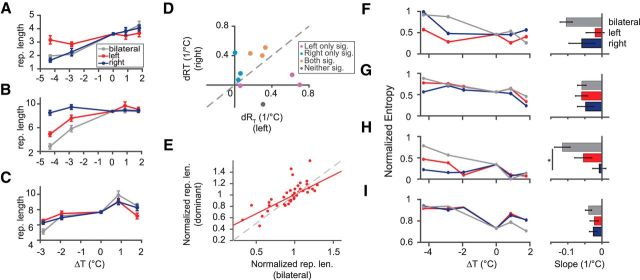Figure 8.
Effects of unilateral HVC temperature manipulation on song syntax. A–C, Examples of variation in mean repetition length with respect to HVC temperature. Effects of left HVC cooling (red lines), right HVC cooling (blue lines), and bilateral cooling (gray lines) are shown. In A, right HVC cooling has a similar effect to bilateral cooling (p = 0.99, Tukey–Kramer post hoc test), whereas left cooling has a smaller effect than bilateral cooling (p = 9.2 × 10−4); in B, left cooling is similar to bilateral cooling (p = 0.39), whereas right cooling has no effect; in C, both left and right cooling have similar effects to bilateral cooling. D, Comparison of the rate of repetition reduction with cooling (dRT) between left and right HVC cooling for all repeated syllables in the unilateral cooling experiment. The gray line is y = x. E, Comparison of mean repetition length between dominant side cooling and bilateral cooling. The repetition lengths are normalized to the mean length in the normal condition. Red line is the linear fit. The gray line is y = x. F–I, Changes of transition entropy with unilateral and bilateral HVC cooling for the four significantly affected branch points (Fig. 4). Entropies are normalized by the maximum possible values. Syllables in F, G, and I show no difference among the three conditions (ANCOVA, p > 0.05); the syllable in H shows a significantly weaker effect for right HVC cooling than bilateral cooling (F = 5.87, p = 0.0184, ANCOVA).

